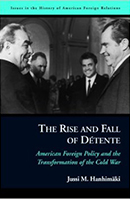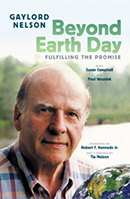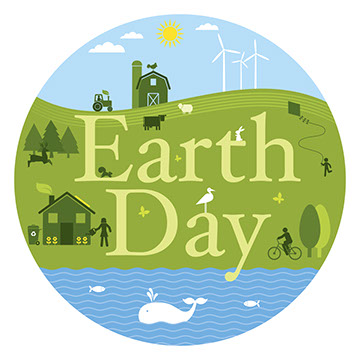One Stem at a Time
By Teresa Kim

Gaylord Nelson, Susan Campbell, Paul Wozniak
Gaylord Anton Nelson grew up in Clear Lake Wisconsin where he fostered a love for nature. Susan Campbell of Milwaukee, Wisconsin is an environmental journalist and communications manager for the Alliance of the Great Lakes. Paul A. Wozniak works as a member of the Board of Governors at Wisconsin Conservation hall and an environmental historian.





“A public armed with knowledge is armed with the means and determination to find a solution.”1 In Gaylord Nelson, Susan Campbell, and Paul Wozniak’s book Beyond Earth Day: Fulfilling the Promise, Nelson, the founder of the internationally-acknowledged modern Earth Day and environmentalist movement, follows up on the environmental issues and concerns he addressed during his very first Earth day “teach in”—which took place nearly 42 years before. The book’s structure shapes the work into an easily comprehensible explanation of the urgency of the environmental challenge and the solutions which anyone and everyone can take the initiative to implement. Nelson and his co-authors start off the book by going back to the period of the 1970s and even before, to examine the forces which shaped the need and execution of the very first Earth Day while also delivering an up-to-date “report card” of sorts on the current environmental status of the planet. Afterwards, it stresses the changing nature of pollution and the reaction and propositions from scientists who are knowledgeable on the specific risks the changes may pose. Furthermore, a comparison is drawn out between the environmental movement from the 1970s versus the environmental movement today, and finally, the argumentative work closes with a reminder of the principles Nelson has been promoting for decades. Overall, however, Nelson claims his central purpose of Beyond Earth Day: Fulfilling the Promise is to call the public’s attention to the most urgent, modern environmental issues facing this planet and reawaken the sense of urgency which had kick-started the environmental movement decades ago.
Nelson, Campbell, and Wozniak start off their collaborated work by first addressing the causes and events which first brought environmental issues to a sense of recognition and urgency back in the 1970s, leading to Nelson’s founding of the modern Earth Day. In addition, they provide their readers with an accurate account of the current environmental quality status in various aspects, including air and water quality, smog factor, and species extinctions data. Restating the founding Earth Day’s principal goal of inspiring a public demonstration to pressure the political establishment out of its inactiveness in solving environmental issues, the authors review the series of events which occurred before Nelson gained approval and permission to launch Earth Day. Included in this detailing were the many struggles on Nelson’s part to persuade political officials to take part in his cause; for example, when after much toil and diligence, Nelson succeeded in persuading John Kennedy to go on a national conservation tour to give visibility to the issue, the plan failed to make any progress as Kennedy’s true indifference to the topic showed in his repeatedly lethargic and dull presentations. The section also provides insight into the turn of events which inspired Nelson’s idea for an environmental “teach-in” in the first place; in the 1970s when anti-Vietnam war “teach-ins” were spreading to college campuses all over the nation around the same time Nelson’s concern and passion for environmental change became stronger, a “lightbulb moment” caused Nelson to combine the concept of teach-ins with that of environmental issues, dubbing it “Earth Day.” Continuing forth, the book lists out the progress the environmental movement has made since the 1970s, including the Clean Air Act and Clean Water Act which were two of the most influential environmental laws put into place. The authors then point out the increasing threats to the environment including but not limited to the effect of storms, heat waves, floods, the quickening extinction of species, and the growing presence of fossil fuels. Throughout the entire section, however, the key idea often refreshed over the course of the chapters is the idea that “we can’t reverse the destruction, but we can slow and conceivably halt it.”2
The following areas of focus extend the detailing given to the most serious and current environmental threats and their potential effects and implications on the United States and the world. In addition, the changing nature of pollution due to the steady increase in synthetic chemicals and byproducts as well as the risks those pose to the environment are discussed along with the influence of humans on these changes and their rates of growth. Right off the bat, species extinctions, global climate change, the collapse of ocean fisheries, and other forms of deterioration and damage are named as areas in which every nation should be taking responsibility for and seeking sustainability in. It is noted that through research conducted by various experts, currently, the most critical issue affecting the environment is population growth, which exceeds the carrying capacity of the planet and is quickly consuming the world’s resources to maintain the current standard of living. Then, population growth and its’ impact are examined and analyzed by taking in factors such as the first agricultural revolution and fluctuations in birth rate. “Flat-world thinking” is introduced as a concept used consistently later on over the course of the entire book. In the authors’ words, “flat world thinking” is when “we see the horizon stretched out before us infinitely when we need to see the world as an actual planet with actual limits.”3 Using this concept as a base of argument and persuasion, the effects of the human ignorance in caring for the environment are meticulously drawn out, presenting exactly how smog and the deterioration of air and water quality can affect not only the physical aspect of the surrounding landscapes but also the biological health and functioning of the human body. This topic leads into the history of a pesticide known as dichlorodiphenyltrichloroethane, or DDT, which was a widely used and highly harmful pesticide used by farmers before Nelson organized its ban in Wisconsin, which would later spread to other states. DDT is then discussed even further in Silent Spring by Rachel Carson when she describes its role in the passing of the Food Quality Protection Act, one of the most notable gains in the 1990s. Concluding this extended account of the most serious topics of environmental threat, she claims, “we must continue to find alternatives. We must learn more about the latent hazards in the chemicals we spread. Above all, we must not blind ourselves to nature’s recurring warning.”4
The next collective topic the work discusses is the comparison of the environmental movement in the 1907s to today, which the authors accomplish by revisiting the environmental movement and assessing its accomplishments as well as shortcomings over the years. The work also addresses the questions of whether the movement today—which has come a long way—is strong enough to tackle the newfound environmental issues garnered over the increased usage of chemicals and output of smog through industrial pursuits. In evaluating the movement, experts’ attempts to understand the reasons for the decreased amount of public fervor and participation in environmental concerns are compared to those of decades ago. The collective impact of small, individual acts against the environmental health as well as the lack of presidential or congressional leadership in the environmental movement are regularly pointed out as the main factors to the decreasing amount of impact made by the modern environmental movement. Theories explaining the potential reasons for decreased environmental support and the analysis of active participants’ motives and how those can be applied to the in active make up the remainder of the section. An example of the broader, more highly stressed options for reinvigorating the public for environmental change is to integrate the topic into educational standards, because eventually, “That understanding will guide their choices and actions throughout life. The connection is there—we need only to point it out.”5 In these ways, the evaluation of the strengths and weaknesses of the environmental movement allowed for its eventual increase in membership and popularity.
Beyond Earth Day: Fulfilling the Promise closes with a clear, thought-out agenda listing the various ways and methods the community can begin to or continue to stay involved in helping environmentalists achieve sustainability in the world. Forging a society of sustainability is dubbed as the collective, international goal while the collective challenge is to attempt to create that society without exceeding the carrying capacity of its resource base. In addition to giving options to how individuals can help make a difference in their own communities, whether by petitioning for the addition of environmental education in teaching standards, stopping personal use of pesticides, or volunteering at a local community clean-up center, the book incorporates reasons why these actions must be taken not at one convenience but right now because “the longer we delay, the more we undermine the livable quality of the environment and the resource base.”6
From the opening of his book, Gaylord Nelson clearly stated his central goals and purposes in writing this book with the help of Susan Campbell and Paul Wozniak. He states his purpose to be as simple as, “pick[ing] up where we left off thirty years ago.”7 Of course, by this he means to refer to the launching of the modern Earth Day and environmentalism, marked by the Earth Day “teach-in” he led on April 22, 1970 in the form of demonstrations, festivities, and lectures in college campuses across the nation. However, the environment and its health has changed dramatically with the change of industrialization and human treatment of their surroundings, causing the goals of the environmentalist movement to change, increase, and become more cause-specific with the years. In response, Nelson wrote his book with the central argument that his work will sketch out the most serious nation-wide environmental threats in order to motivate the public to rally behind his cause once again—just as he did thirty years ago with the teach-ins. In order to fully address his thesis, Nelson with the assistance of Campbell and Wozniak reminds his audience of the primary reasons environmentalism is crucial to the planet’s well-being and the magnitude of growth and success the cause has found over the years. For example, Nelson reveals that in its beginning stages, the first Earth Day received contribution from only one major corporation—Arm and Hammer. However, corporate leadership at both the top and middle management levels have come to take part in Earth Day regularly, serving to show that the environmentalist movement is not as some might say “a lost cause,” which strengthens the credibility of Nelson’s right to be asking the public to rally. Another implied clause of Nelson’s thesis is a warning of exactly how impactful the state of the environment can be to their personal lives, observable by the extensive overview of health consequences Nelson includes in his book; for example, he notes that some pesticides, if used in certain dosages, may cause “cancer, injury to the nervous system, lung damage, and reproductive problems.”8 Lastly, another implied clause in Nelson’s thesis is his proposition to incorporate environmentalism into educational curriculum, in order to “nurture a generation imbued with a guiding environmental ethic that prompts each individual to always as: If we intrude here, what will be the environmental consequence?”9 With this move towards educational incorporation of environmental curriculum, Nelson addresses his primary goal of widening the support base for the modern Earth Day movement through the growing generations.
Gaylord Nelson is widely acclaimed as the chief founder of both Earth Day as well as the world-wide environmentalist movement; therefore, it’s imperative to understand his roots to truly comprehend where his unwavering views on environmental health hail from. Growing up in Clear Lake, Wisconsin, Nelson “saw the natural world as his playground,” of sorts, and spent his time fishing and swimming in the lakes.10 His love for nature went with him after his decision to run for public office and dedicate himself to public service after hearing and becoming inspired by a speech by Robert La Follete Jr. in his early childhood. Combining his passion for nature and his skill in the area of law and politics, Nelson developed his rock-solid drive to support protection and conservation of nature.
In 1960s America, Nelson began his attempts to crack down on political agendas, raise awareness, and garner attention for environmentalism within the sphere of the nation’s top leaders. However, “the issues of civil rights and foreign policy dominated the national discourse at the time,”, meaning there would be less people willing and patient enough to take time out of those issues to address environmentalism—a seemingly trivial topic in comparison to those such as the Vietnam War, for example.11 Because of this, even when Nelson succeeded in persuading J. F. Kennedy to agree to a national conservation tour, the citizens gave their attention to the anti-war demonstrations going on at the time. However, during the 1960s and 1970s, the increasingly poor quality of the air and water drew attention to Nelson’s efforts. Beyond Earth Day: Fulfilling the Promise was written to remind the people of what drew them to the teach-ins all those years ago—the worsening conditions of the nature making up this planet and the responsibility of the people to take initiative and save it.
A point of widespread agreement in regards to Gaylord Nelson’s work as noted in many book reviews of Beyond Earth Day: Fulfilling the Promise seems to be that he possesses a skill allowing his confidence to be felt through his written words, “lavishly deliver[ing] the issues to the conscience of the country and beyond.”12 John Rohe, one of the many reviewers of Beyond Earth Day: Fulfilling the Promise, expresses in his summer review publication in the Social Contract Journal that Senator Nelson was successful in concisely explaining the history of Earth Day while shedding light on the current and future issues in dire need of attention. In the 2003 Californians for Population Stabilization journal review, Meredith Burke strengthens Rohe’s opinion by also commenting on Nelson’s unrestricted and confident explanations and theories, describing him as “pulling no punches.”13 In summary, Nelson, Campbell, and Wozniak garnered positive feedback in their combined work, with many readers saying they did, indeed, remember and can relate to the observable environmental problems discussed.
Beyond Earth Day: Fulfilling the Promise, overall, provided a highly thought-out, clear, and concise context as to how the environmentalist movement evolved and changed its goals in order to match up with the larger number of natural resource related issues facing the planet today. By doing so, it persuasively highlighted the need for motivation and drive within each and every individual living on this planet to help out with the cause because “even if you do not participate, you have a right to breathe clean air, and to fish and swim in our lakes.”14 Also, by giving abundant amounts of statistics and survey results such as the report that “83% of Americans say they agree with the goals of the environmentalist movement,” the work helps to persuade the readers that the environmentalist movement has been gaining traction and for serious reasons and cause.15 Nelson’s principles are explained realistically and relatable enough to follow, allowing the issue of environmental care to be brought to a more personal level.
In light of the bigger picture, Gaylord Nelson during the 1970s in accordance with his tireless attempts to fight for environmental laws, convert political leaders into environmentalists, and garner public attention and membership to his cause, strengthen the fact that Nelson saw the 1970s as a period of desperate need for environmental protection reform. Although Earth Day is known to have begun in the 1970s, Nelson’s account states that the entire process “evolved over a period of seven years starting in 1962.”16 From there, the build-up of Nelson’s attempts at reform culminated in his teach-in movement during the 1970s, showing that the authors of this book clearly see the 1970s as a continuation of the 1960s.
Beyond Earth Day: Fulfilling the Promise serves as an exemplar model to present-day society how to make environmentalism easy to understand and simple to take part in. For anyone interested in making a difference or even those who have no interest in the environment, this collaborated work effectively portrays the importance that “all of us do must do our part, and we must demand our leaders do their parts as well. If we can accomplish this, there is no reason to fail.”17
1. Nelson, Gaylord. Campbell, Susan. Wonziak, Paul. Beyond Earth Day: Fulfilling the Promise. Madison: The University of Wisconsin Press, 2012. xxiii
2. Nelson, Gaylord. Campbell, Susan. Wonziak, Paul. 16.
3. Nelson, Gaylord. Campbell, Susan. Wonziak, Paul. 53.
4. Nelson, Gaylord. Campbell, Susan. Wonziak, Paul. 102
5. Nelson, Gaylord. Campbell, Susan. Wonziak, Paul. 115
6. Nelson, Gaylord. Campbell, Susan. Wonziak, Paul. 133.
7. Nelson, Gaylord. Campbell, Susan. Wonziak, Paul. xxiii.
8. Nelson, Gaylord. Campbell, Susan. Wonziak, Paul. 91.
9. Nelson, Gaylord. Campbell, Susan. Wonziak, Paul. 151.
10. Rome, Adam. The Genius of Earth Day: How a 1970 Teach-In Unexpectedly Made the First Green Generation. New York City: Hill and Wang. 2013. 21.
11. Nelson, Gaylord. Campbell, Susan. Wonziak, Paul. xix.
12. Rohe, John. “Gaylord Nelson and Earth Day: The Senator Who Helped Turn Many of Us into Environmentalists.” Social Contract Journal 13.4 (n.d.): n. pag.
13. Burke, Meredith. “Book Review.” Population and Environment 24.6 (2003): 571-75.
14. Nelson, Gaylord. Campbell, Susan. Wonziak, Paul. xvii.
15. Nelson, Gaylord. Campbell, Susan. Wonziak, Paul. 106.
16. Nelson, Gaylord. Campbell, Susan. Wonziak, Paul.3.
17. Nelson, Gaylord. Campbell, Susan. Wonziak, Paul. 157.




4 - 4
<
>